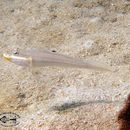Diagnostic Description
(
Anglèis
)
fornì da Fishbase
Has 2 to 3 blue-bordered red longitudinal stripes on the head that extends faintly on the body, as well as red basal stripes on the dorsal and anal fins, a dark tip on the first dorsal fin, and red ocelli on the caudal fin; characterized further by pale grey body color on back, grading to white on lower side; without filamentous dorsal spines; rhomboid caudal fin, longer than head; length of caudal fin 2.8-3.5 in SL; longitudinal scale series 73-94; ctenoid body scales, becoming cycloid anteriorly below anterior part of fist of first dorsal fin; head or midline of nape without scales; side of nape with scales extending forward above middle to front of operculum; base of pectoral fin scaleless; usually partly scaled prepelvic area in adult; depth of body 5.1-6.2 in SL (Ref. 90102).
- Recorder
- Cristina V. Garilao
Life Cycle
(
Anglèis
)
fornì da Fishbase
Oviparous, distinct pairing during breeding (Ref. 205). Pairs form upon maturation for breeding purposes (Ref. 56281, 58559). Monogamous mating is observed as both obligate and social (Ref. 52884).
Morphology
(
Anglèis
)
fornì da Fishbase
Dorsal spines (total): 7; Dorsal soft rays (total): 12; Analspines: 1; Analsoft rays: 12
- Recorder
- Cristina V. Garilao
Trophic Strategy
(
Anglèis
)
fornì da Fishbase
Inhabits shallow coastal sand and rubble flats, often near mangroves (Ref. 48637). Occurs in areas of fine sand in shallow lagoon reefs. Adults occur in pairs while juveniles were often seen in small groups. Feeds on small invertebrates by sifting mouthfuls of sand.
- Recorder
- Drina Sta. Iglesia
Biology
(
Anglèis
)
fornì da Fishbase
Inhabits shallow coastal sand and rubble flats, often near mangroves (Ref. 48637). Occur in areas of fine sand in shallow lagoon reefs. Adults occur in pairs while juveniles were often seen in small groups. Feed on small invertebrates by sifting mouthfuls of sand. Monogamous (Ref. 52884). Oviparous (Ref. 205). Breeding pairs are commonly found sharing a single burrow (Ref. 56281).
- Recorder
- Estelita Emily Capuli
Valenciennea muralis: Brief Summary
(
Catalan; Valensian
)
fornì da wikipedia CA
Valenciennea muralis és una espècie de peix de la família dels gòbids i de l'ordre dels perciformes.
- licensa
- cc-by-sa-3.0
- drit d'autor
- Autors i editors de Wikipedia
Valenciennea muralis: Brief Summary
(
Spagneul; Castilian
)
fornì da wikipedia ES
Valenciennea muralis es una especie de peces de la familia de los Gobiidae en el orden de los Perciformes.
- licensa
- cc-by-sa-3.0
- drit d'autor
- Autores y editores de Wikipedia
Valenciennea muralis
(
Basch
)
fornì da wikipedia EU
(RLQ=window.RLQ||[]).push(function(){mw.log.warn("Gadget "ErrefAurrebista" was not loaded. Please migrate it to use ResourceLoader. See u003Chttps://eu.wikipedia.org/wiki/Berezi:Gadgetaku003E.");});
- licensa
- cc-by-sa-3.0
- drit d'autor
- Wikipediako egileak eta editoreak
Valenciennea muralis: Brief Summary
(
Basch
)
fornì da wikipedia EU
Valenciennea muralis Valenciennea generoko animalia da. Arrainen barruko Actinopterygii klasean sailkatzen da, Gobiidae familian.
- licensa
- cc-by-sa-3.0
- drit d'autor
- Wikipediako egileak eta editoreak
石壁凡塘鳢
(
cinèis
)
fornì da wikipedia 中文维基百科
二名法 Valenciennea muralisQuoy et Gaimard, 1837[1] 石壁凡塘鳢(学名:Valenciennea muralis)为輻鰭魚綱鱸形目鰕虎魚科凡塘鳢属的鱼类,俗名石壁美塘鳢。
分布
本魚分布于印度西太平洋區,斯里兰卡、印度、泰国、菲律宾、印度尼西亚、澳大利亚、密克罗尼西亚、美拉尼西亚、波利尼西亚以及中国南海等海域。该物种的模式产地在Vanicolo。[1]
深度
水深1至16公尺。
特徵
本魚體延長呈圓柱狀,眼睛突出,腹鰭癒合成吸盤。魚體白色,具數條淡橘色縱帶,第一背鰭具一明顯黑斑,尾鰭圓形,背鰭硬棘7枚;背鰭軟條12枚;臀鰭硬棘1枚;臀鰭軟條12枚,體長可達16公分。
生態
本魚棲息在礁岩外圍沙地,居住於洞穴中,生性機警,屬肉食性,以小型無脊椎動物為食。
經濟利用
可做為觀賞魚。
参考文献
-
^ 1.0 1.1 中国科学院动物研究所. 石壁凡塘鳢. 中国动物物种编目数据库. 中国科学院微生物研究所. [2009-04-16]. (原始内容存档于2016-03-05).
扩展阅读

这是一篇與
鱸形目相關的
小作品。你可以通过
编辑或修订扩充其内容。

石壁凡塘鳢: Brief Summary
(
cinèis
)
fornì da wikipedia 中文维基百科
石壁凡塘鳢(学名:Valenciennea muralis)为輻鰭魚綱鱸形目鰕虎魚科凡塘鳢属的鱼类,俗名石壁美塘鳢。

